#phyllotopsis nidulans
Explore tagged Tumblr posts
Text
How to Identify Late Oyster Mushrooms
Click here to learn more about the How to Identify article series.
Name: Late oyster mushrooms (Sarcomyxa serotina)
Range and typical habitat(s): North American west, United States east of the Great Plains, widespread across Europe, extreme east Asia
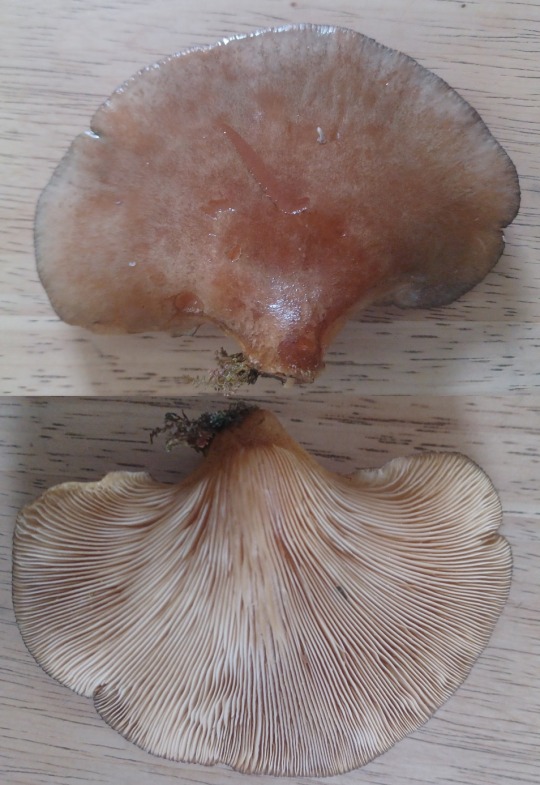
The top and underside of a late oyster mushroom.
Distinguishing physical characteristics (size, colors, overall shapes, detail shapes): At first glance the this looks like any other oyster mushroom, with its round, shelf-shaped appearance. However, where true oysters (Pleurotus spp.) tend to be gray or white in appearance, the slimy-textured cap of the late oyster can be anywhere from orange to olive-green to violet-tinted, and can grow up to six inches across. The gills are usually yellow to orange, and while some may remain single from the stipe to the edge of the cap, others fork at least once.
Young late oyster mushrooms may have edges that roll under, but when mature they open to a flatter shape, sometimes with a gently scalloped edge. The stipe is quite unique with its fuzzy texture, and is generally very short. The tightly-packed gills are adnate, meaning that they attach to the stipe with their entire width, rather than becoming shorter in height as they approach the stipe. Take a spore print of a late oyster mushroom, and you’ll find a cream to yellow print. The flesh does not bruise or otherwise discolor when damaged.
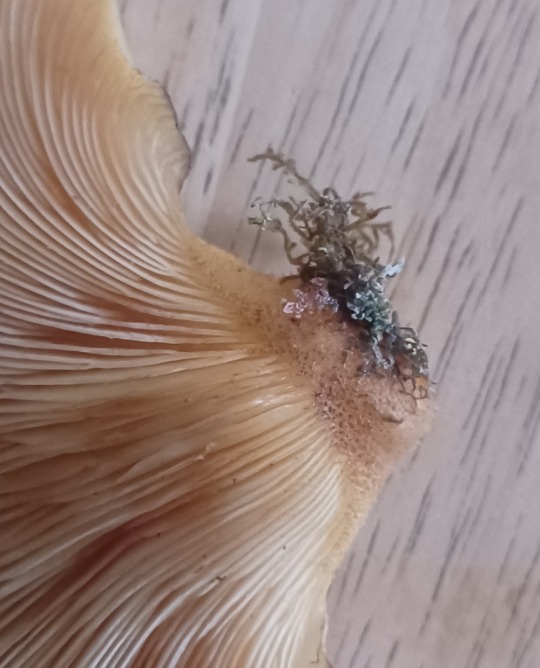
Notice the texturing on the stipe of this late oyster mushroom.
Like oyster mushrooms, late oysters grow in clusters on decaying hardwood trees, like maples and alders. They gain their “late” name for their tendency to fruit in fall to early winter; October to December is prime time for this fungus. Even in areas that receive frosts and freezes, the mushrooms may keep on growing in spite of the cold.
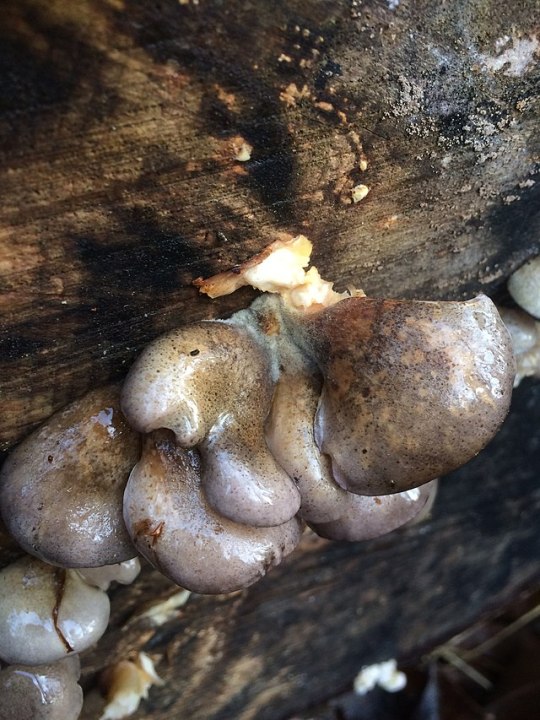
Other organisms it could be confused with and how to tell the difference: Again, true oyster mushrooms bear the most resemblance to late oysters. In addition to being less colorful–gray to white being most common–true oysters have a smooth rather than fuzzy stipe. Their spore print is usually white, occasionally with a slight purple tint. Finally, the gills of true oysters continue down the stipe (decurrent), while the late oyster’s gills stop at the stipe.
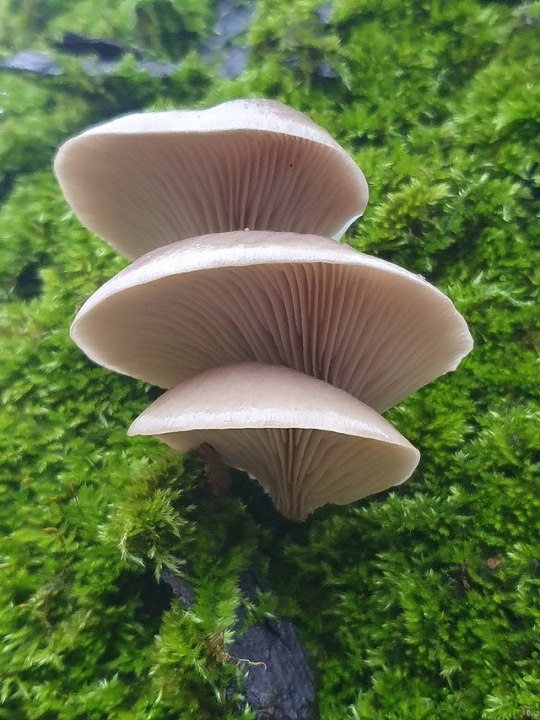
Oyster mushrooms (Pleurotus ostreatus)
Angel wing mushrooms (Pleurocybella porrigens) are another white mushroom found growing on dead wood. They lack the late oyster’s color variety and have decurrent gills that produce white spores, and their flesh tends to be more delicate. Most importantly, angel wings grow on decaying conifers while late oysters grow on hardwood trees, and they fruit in late summer into fall, but not to winter. Angel wing mushrooms used to be considered edible, but a series of poisonings several years ago has put their edibility into question.
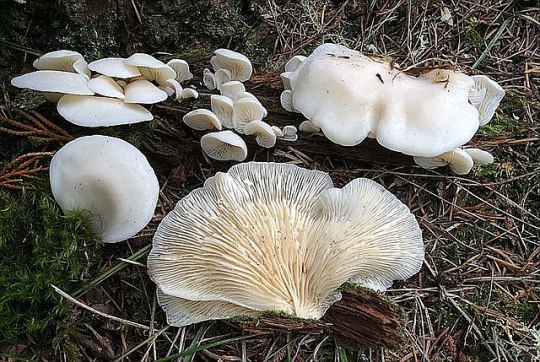
Angel wing mushrooms (Pleurocybella porrigens)
Shoehorn oyster mushrooms (Hohenbuehelia petaloides) may sometimes look a bit like a brown-tinted late oyster mushrooms, but look underneath and you’ll see the white gills are decurrent, and they have a white spore print. Also, they tend to grow on woody debris rather than tree trunks, and will fruit anywhere from spring through fall.

Shoehorn oyster mushrooms (Hohenbuehelia petaloides)
The only other significant inedible lookalike besides angel wings is the mock oyster (Phyllotopsis nidulans). The orange cap may look similar to an orange-colored late oyster, but it has a fuzzy texture all over instead of only on the stipe. The gills produce orange to peach spores, are decurrent, and not as tightly packed as on the late oyster. A strong stench is the best way to identify the mock oyster, and should you try eating one it has an equally unappealing flavor and tough texture.
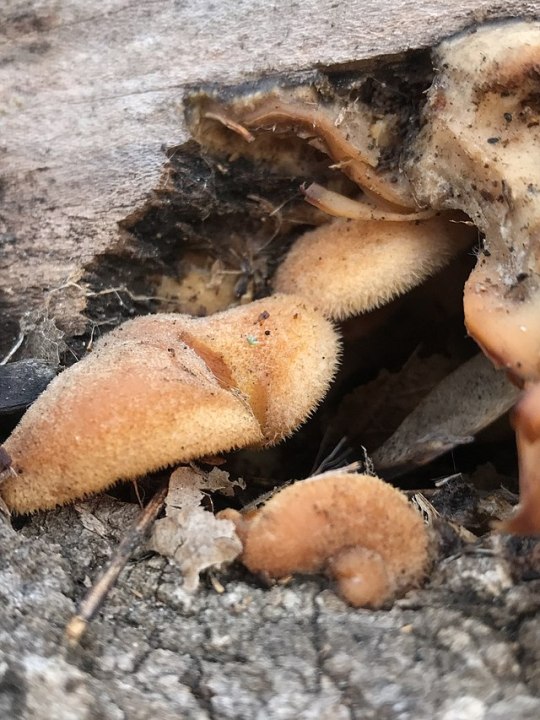
Mock oyster mushrooms (Phyllotopsis nidulans)
Anything else worth mentioning? Late oyster mushrooms are considered edible, though with a rather bland, unexciting flavor. Their texture is good, though, and they lend themselves well to being vehicles for sauces and other flavoring agents. Some people report they can be bitter if the top layer is not peeled off, and it is strongly recommended that they be cooked longer than some other mushrooms, at least 15-20 minutes. This can reduce the chance of gastrointestinal upset, but as always it is best to only try a very small amount of a new mushroom when eating it for the first time, and you MUST make absolutely sure you are 100% certain that what you are about to eat is an edible species.
Further reading:
Late Fall Oyster: Identification, Foraging, and Preparing
Late Fall Oyster Mushrooms: Sarcomyxa serotina
Late Fall Oyster (Panellus serotinus) — Identification & Medicinal Benefits
Late Fall Oyster: Sarcomyxa serotina
Did you enjoy this post? Consider taking one of my online foraging and natural history classes or hiring me for a guided nature tour, checking out my other articles, or picking up a paperback or ebook I’ve written! You can even buy me a coffee here!
#late oyster mushrooms#oyster mushrooms#edible mushrooms#edible fungi#foraging#mushroom foraging#mushroom hunting#shrooms#fungi#fungus#mycology#nature identification#nature#ecology#food#wild foods
18 notes
·
View notes
Text

Mock oyster mushroom
Phyllotopsis nidulans
Edible, but not recommended because it tastes like sewage. Also called stinking orange oyster.
0 notes
Text



Mock Orange Oyster - Phyllotopsis nidulans
#mushrooms#mycology#fungi#forestcore#mycophile#eye on the forest floor#Phyllotopsis nidulans#mock Orange Oyster
70 notes
·
View notes
Photo
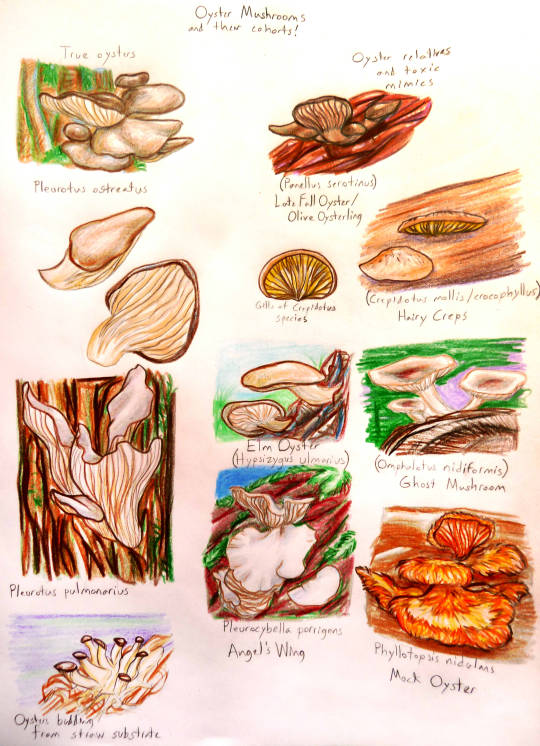
A handy cheatsheet guide to determining if, truly, what you have poppin' out of your local stump are oyster mushrooms or a close relative. While oysters are a good beginner mushroom to forage they do have a number of look-alikes, most of which are also edible mushrooms. However, a few are mildly toxic and should be avoided, and it's always smart to exactly which mushrooms you're eating, oyster or edible relative. Key Pleurotus ostreatus (True Oyster or Winter Oyster) traits: -Always grows from wood, typically hardwoods that still retain some of their bark layers. -Grows out in flat, gilled shelves in dense clusters that often share a stem. -Pale gills, from pure white to cream colored, which run in parallel down the visible stem portion. -Thick, substantial cap flesh and meaty stems which are almost always off-center. Most of the time, oyster mushroom caps and stems will be shelf-like, with no gills developing on the back side at all (this might be different if the mushroom is growing straight up from the top of a log or stump. -Spore print of oysters is always white. -Unusual but pleasant aroma, most similar to aniseseed. -Cap color is usually tan or grey, with a variance in darkness and hue. The cap will always be darker than the stem and gills. -Large size, usually the mature, flattened out caps will be no smaller than 2 inches across. Pleurotus pulmonarius, also known as the Summer Oyster, is a close cousin and is also a very choice edible. The differences are: -Summer species can only be found in, you guessed it, summer months. -Cap is usually somewhat paler than the Winter Oyster. -Prefers growing from the top side of logs and stumps, maturing into almost tubular fan-shaped mushrooms. It is overall a longer stemmed mushroom that does not spread out to as wide a shelf. Another oyster species, not pictured, is the Golden Oyster (Pleurotus citrinopileatus), which is identical to Summer Oysters except for its lovely golden color. Oyster mushrooms, after the common Button Mushroom and Shiitakes, are one of the most often cultivated species in the world with growing them in straw substrate in greenhouses the most common method. They are even reported to thrive in and sprout from old spent coffee grounds! Kits can even be bought online where everyday mushroom lovers can grow huge tufts of tasty 'shrooms from a box indoors. Most cultivated oysters are the winter species, Pleurotus ostreatus. There are plenty of relatives and mimics to Oyster Mushrooms found growing on various types of wood throughout the world, and in the interests of celebrating them and foraging safety I have included illustrations of them on the right side of the page as well. Late Fall Oyster/Olive Oysterling: This mushroom is an edible and medicinal mushroom, most commonly foraged for food in Japan where it is known as Mukitake, though it can be found across the entire northern hemisphere in temperate forests. It is extremely oyster-like in shape and growing habits, and typically appears in, you guessed it, late fall (and sporadically in winter warm spells). They are frequently enjoyed by deer and squirrels as a food source in winter. Panellus serotinus identification traits: -Oyster-like cap and stem arrangement, with branching shelves of caps being the common growth pattern. -Cap color is usually a faint olivey green, though it can also be brownish or tan. -Gills are cream-colored and run to the stem where they attach. Unlike Oysters, the gills do not run all the way down the stem. -Stem is thick and stubby, often branching to form multiple caps. -Typically smaller than an Oyster mushroom, cap size between 1 and 1.5 inches across. -Spore print is cream colored, buff, or light tan. Crepidotus species: Crepidotus species, often referred to as "Creps", are generally not regarded as edible though none are known to be dangerous. They can often be mistaken for small oyster mushrooms by novice foragers but there are many observable differences between the two genera. Pictured is the most common Crep in the Eastern U.S., Crepidotus mollis or Crepidotus crocophyllus, the Hairy Crep which has very obvious wiry hairy structures on the cap and a pale orange to yellow cap. Crepidotus identification traits: -Typically grows on more degraded wood, sometimes nearly disintegrated stumps. -Colors range by species: can be white, tan, light orange, or yellowish. -Almost never grows in clusters, more often in single caps scattered across the log or stump. -Never has a visible stem, but instead attaches directly to the wood. -Many have a slightly hairy or scaly cap skin which is easy to peel from the cap flesh. -Cap flesh itself is very thin and insubstantial, watery. -Gills are typically yellowish colored and do not run parallel. Instead, they all originate from a single central point where the cap is attached to the wood. -Typically do not exceed 2 inches in cap width. -Spore prints are orange-brown to brown, never white. Elm Oyster (Hypsizygus ulmarius): A pleasant edible mushroom that was once categorized as a true Oyster species, it has since been rightfully given its own genus. The Elm Oyster is always found on dead or dying Elm trees and from a distance looks exactly like a Winter Oyster. However, up close it has a few distinguishing characteristics. Hypsizygus ulmarius identification traits: -Always on elm wood, usually dying elms or recently dead trees. -Has an off-center stem which is fleshy, tough, and pale in color with faint vertical striations running down it. -Has pale, cream-colored gills which run slightly down the stem. -Always lacks a stem ring (annulus). -The tan cap, which tends to crack with age and lack of humidity, is slightly convex to flattened. Often has a few small scales or hairs on its surface. -Often grows in cluster, though from individual stems that do not branch. Ghost Mushroom (Omphalotus nidiformis): A toxic mushroom that may be mistaken for Oysters or Elm Oysters in its native regions of Southeast Asia and Australia, but more important to learn lately due to spots of invasive populations in the rest of the world. This fungi is interesting for its non-culinary properties, for while it is toxic it is also a bio-luminescent species that glows a wonderful lime green color in the dark. It is a close relative of the bright yellow-orange Jack-o-lantern Mushroom, Omphalotus olearius--which is also toxic and bio-luminescent! Omphalotus nidiformis identification traits: -Grows on degraded wood most often. -Has a mostly-central stem. Often grows in branching clusters, but never in shelf-like clusters. -Cap flattens rapidly with age, often becoming upturned at the edges. -Cap is whitish in color, typically with a dark stained area towards the center. -Gills are pale and run down the stem somewhat. -Glows in the dark. -Lacks an annulus (stem ring). -Spore print color is white. Angel Wing (Pleurocybella porrigens): Well now... this would have to be my first "controversial mushroom" I cover, as it has sparked some fear due to recent deaths attributed to it in Japan, where it is known as Sugihiratake. To date over 40 people, all in Japan, have reported severe poisoning symptoms after consuming this species of mushroom. However, especially in the Pacific Northwest, this species is foraged and consumed with no incident. I'm not convinced this is the "deadly toxic mushroom" often warned about in top ten lists... I'm actually pretty sure this is an edible mushroom with possibly a high number of allergic people or a variant population in Japan only which is toxic. Another theory is that a certain locality of these Angel Wings is contaminated somehow, and the mushroom is picking up the toxic contaminants. I'm going to go forward saying this is an edible species, provided a forager uses caution and avoids specimens gathered in Japan specifically. Pleurocybella porrigens identification traits: -A purely white mushroom, growing in oyster-like, ruffled shelves with very little to no stems. -Very wide caps with thin flesh, similar to a Crepidotus. -Found often in late summer months. -If it has a short stem, the closely-bunched gills will run down it similar to an Oyster mushroom. -Typically found growing on conifer trees and wood, not hardwoods. -Spore print is white. -Caps are typically smaller than Oysters, between 1 and 2 inches wide (though some have been found as large as 4 inches wide). -Faint, mossy aroma which is sometimes sweet (not like aniseseed). Mock Oyster (Phyllotopsis nidulans): A beautiful but toxic mushroom that is sometimes mistaken for oyster mushrooms by very inexperienced foragers. While it does have a similar growth pattern to Oysters and fruits at the same time, it is rather distinct from true Pleurotus or any of its mimics. Never eat this fungus as it is known to be quite toxic, causing vomiting and painful cramps that may last for 48 hours or more. Phyllotopsis nidulans identification traits: -Pale yellow to bright orange mushroom growing from degraded wood of all types. -Branching, thick stems and growing in large clusters. Sometimes the stems are so fused that they sprout multiple caps from each other rather than the stems. -Sometimes has a foul smell, particularly when it grows in abundance. -Top of the cap has at least one thickly hairy zone (an Oyster will never have hairs on the cap!). -Gills run to the stem, but do not run all the way down it. -Spore print color is pale pink. Happy oyster foraging, and remember the safe mycophage's motto: "When in doubt, throw it out!"
#mushroom#mushroom identification#oyster mushroom#oyster mushroom look alikes#traditional media#traditional art#colored pencils#phyllotopsis nidulans#pleurocybella porrigens#crepidotus#pleurotus#omphalotus nidiformis#hypsizygus ulmarius#panellus serotinus
4 notes
·
View notes
Photo
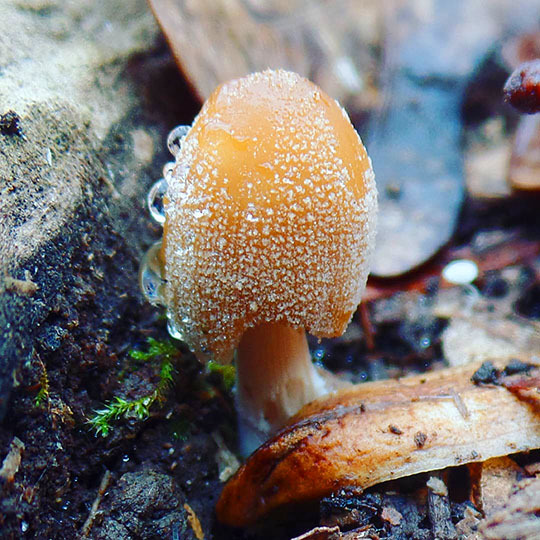



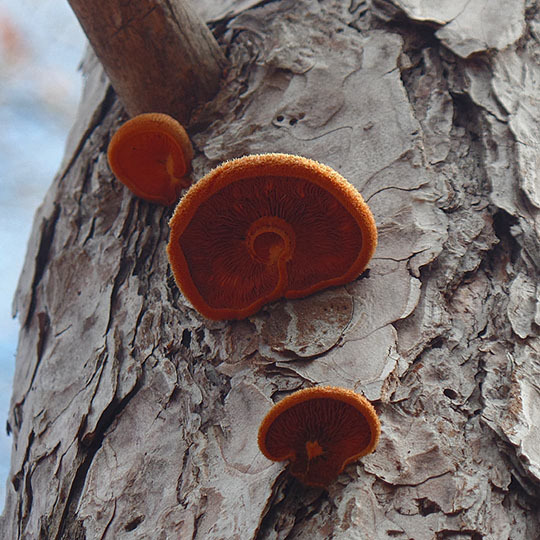

Finally found some mock oysters (Phyllotopsis nidulans, bottom left) but of course they were like 50 thousand feet up.
#mycology#fungi#mushrooms#nature photography#dirtcore#goblincore#forestcore#woods#forest floor#foraging#moss#nature#the fungus among us
431 notes
·
View notes
Text


Phyllotopsis nidulans | Orange Mock Oyster
Late summer to late fall Inedible
This is my first crack at identifying something I don’t know, so my best guess is these are young Orange Mock Oyster mushrooms. I’ve already learned that I should carry my ID book and some paper for spore prints with me, and that I should have smelled this specimen, because those would have given me important clues as to what it is. If it is what I think it is, it should have a strong unpleasant odor and a pink to tan spore print.
I took these pictures January 2nd, which is a bit outside of what my book tells me is its growing season but up until last week we’ve been having an exceptionally mild winter, so things might be a little off?
I’ll have to go look for it again to see if I can confirm the ID and see if it looks any different a week or two out. Provided it survives the sudden plunge into winter temps and weather we’ve just had.
EDIT:
I was able to get back out and find this patch of mushrooms again, and got an updated winter picture of a neighboring cluster. Since these are a few weeks older, you can see the caps aren’t as rolled under as the first pictures.

I was also able to confirm the spore print, a nice pinkish-tan.

#mushrooms#mycology#fungi#orange mock oyster#I love this one#it's so bright in person the pictures don't do it justice
43 notes
·
View notes
Text

orange mock-oyster
Phyllotopsis nidulans
#mycology#mushrooms#wild fungi#fungi#orange mushrooms#foraging#forestcore#cottagecore#botany#biology
53 notes
·
View notes
Photo

The mock oyster mushroom, Phyllotopsis nidulans. To me, it doesn’t look like a typical oyster because it’s orange and peach fuzzy on top. But, it does have gills and a fan shape similar to typical oysters. I didn't think to sniff this outcrop, but supposedly it stinks like cabbage and is very unpalatable. If you want to make some cool spore prints, these guys’ are pink!
#mock oyster#oyster mushroom#lithobates catesbeianus#mushroom#forest floor#forestcore#naturecore#fungi#fungus#fantastic fungi#missouri nature#outdoors#mushroom hunting#nature photography#original photographers
43 notes
·
View notes
Text

Orange Seitling, Phyllotopsis Nidulans 10.05.21
#mushrooms#basidiomycota#fungi#wild fungi#pilze#Phyllotopsis#pilz#pilzesuchen#mycology#mushrooms of switzerland#mushrooms switzerland
7 notes
·
View notes
Photo



Stinking orange oyster fungus, Phyllotopsis nidulans, WG Jones state forest, Conroe, Texas, Montgomery county, 11/16/19
photograph by Paxon Kale
51 notes
·
View notes
Text

Phyllotopsis nidulans
(Mock oyster, Orange oyster)
14 notes
·
View notes
Photo

Phyllotopsis Nidulans, aka Mock Oyster Photo by Troika33 https://www.instagram.com/p/Bv7Vw8Fj7K1/?utm_source=ig_tumblr_share&igshid=1pbd0itcovde2
0 notes
Photo






The queens in yellow (Phyllotopsis nidulans, Tremella mesenterica, and two Amanitas that may be A. flavoconia)💛🍄
#mycology#fungi#mushrooms#foraging#forest floor#nature photography#autumn#woods#hiking#mosscore#moss#amanita#mock oyster#dirtcore#cottagecore#nature#the fungus among us
55 notes
·
View notes
Photo

Phyllotopsis nidulans
3/17 at Umstead State Park, North Carolina
73 notes
·
View notes

